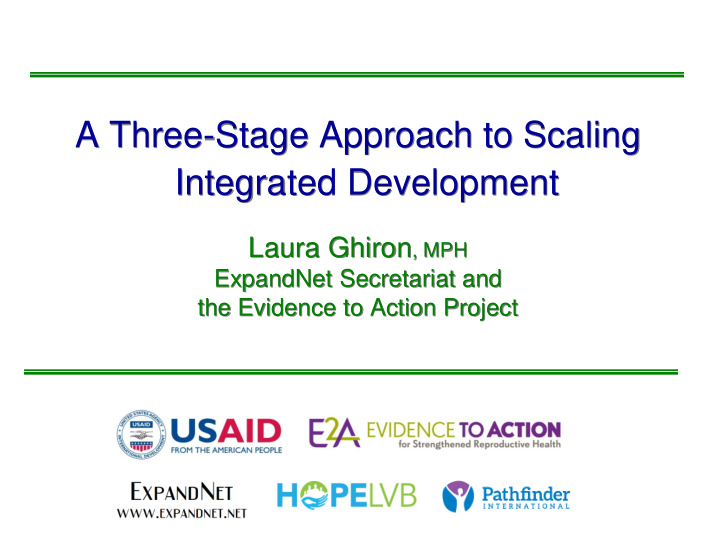



A Three-Stage Approach to Scaling Integrated Development Laura Ghiron , MPH ExpandNet Secretariat and the Evidence to Action Project
ExpandNet Definition of Scaling Up “ Deliberate efforts to increase the impact of innovations successfully tested in pilot or experimental projects so as to benefit more people and to foster policy and program development on a lasting basis .” 2
HoPE-LVB Project sites 3
HOPE-LVB Integrated PHE Model Key Interventions: Key Processes: • Population • Advocacy – Provision of family planning info & • services Participatory needs – Education about population impacts assessment • Health • – Community engagement Sexual and Reproductive health/rights – Maternal/newborn/child health • Building capacity through – Water, sanitation and hygiene – training & supervision Nutrition • Systems strengthening • Environment – • Sustainable fisheries Participatory monitoring – Sustainable agriculture & reporting – Biodiversity conservation – Sustainable livelihood diversification – Tree planting/reforestation Gender equity, Youth
HoPE’s systematic focus on scale up: • Stage I: Design and demonstrate/test a scalable model for integrated PHE in Kenya & Uganda’s LVB regions in ways that build towards future expansion and institutionalization • Stage II: Develop a scaling-up strategy for successfully tested interventions with stakeholders • Stage III: Strategically manage implementation of the scaling-up strategy and process
A three-stage approach for systematic scale up Strategically manage the scaling up Develop a scaling process up strategy (Stage III) (Stage II) Keep the end of scale up in mind throughout project design and implementation (Stage I)
ExpandNet/WHO guidance on designing pilot projects with scaling up in mind 7
Scoping meetings with stakeholders Youth in Malongo, Uganda Beach Management Unit in Rakwaro, KE Uganda Population Secretariat Subcounty officials in Bussi Uganda
Example of what changed as a result of “beginning with the end [of scale up] in mind” WHAT WAS INITIALLY PLANNED: Agro-forestry interventions implemented primarily by project personnel directly with communities ….AFTER GROUP ANALYSIS BECAME: Agro-forestry interventions implemented jointly with village environmental committees, subcounty environment officials, district environmental officers and community members
“One thing that I like about the approach HoPE-LVB uses is utilizing the MOH Community Strategy… using our CHWs and using that strategy, they didn’t employ other institutions, they use the already existing structures… already developed in the community.” - Suba sub-county RH Coordinator, Homa Bay, Kenya
ExpandNet/WHO Nine steps for developing a scaling up strategy 11
The Innovation The Scaling-up User elements of Organization(s) Strategy Resource scaling up Team TYPE OF SCALING UP Strategic choice MONITORING areas ORGANIZATIONAL COSTS/RESOURCE DISSEMINATION AND AND ADVOCACY PROCESS MOBILIZATION EVALUATION 12
Strategically manage the scaling up Develop a process scaling up strategy Keep the end of scale up in mind throughout project implementation
Some key institutionalization outcomes of using a systematic approach • In Kenya , Homa Bay and Siaya Counties established PHE steering committees which have incorporated and budgeted for PHE implementation in five-year County Integrated Development Plans • In Uganda , the Ministry of Health has adopted a key HoPE concept in their new strategy, while at district levels the government is replicating demonstration sites with minimal support from the HoPE team • Regionally , Lake Victoria Basin Commission supporting efforts of PHE working groups in five member-nations
Challenges to scaling PHE • Existing national/regional policies promote integration but lack implementation strategies • Verticalized sectors, personnel and funding streams are not conducive to implementing integrated approaches HOWEVER , largely because of the systematic approach to scale up, PHE has gained powerful momentum in East Africa, in spite of systemic obstacles.
Recommend
More recommend